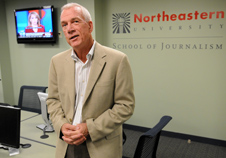3Qs: Priest abuse study called ‘deeply flawed’

Researchers at the John Jay College of Criminal Justice this month released the results of a study, commissioned by the United States Conference of Catholic Bishops in 2002, examining the causes of the sexual abuse crisis within the Church. The report, which places blame not on church leaders but on the permissive culture of the 1960s and 1970s is “deeply flawed” says Walter Robinson, distinguished professor of journalism at Northeastern University, who led the Boston Globe Spotlight team that broke the clergy sex abuse story, netting the paper the Pulitzer Prize for Public Service in 2003.
What is your immediate takeaway from the John Jay study, which says the sexual abuse crisis was the result of cultural changes in 1960s and ‘70s?
Like everybody else, I was drawn to what you could call this “third-rail conclusion” that the supposed surge in the incidence of sexual abuse by priests in the ’60s and ’70s was somehow caused by the permissiveness of that era. The report cited such things as divorce, drug use, crime and premarital sex as somehow being instigating factors that made priests abuse children.
The fact of the matter is that the data is deeply flawed. So to draw any kind of conclusion like that is, I think, unwarranted. It is more likely that the incidence of abuse of minors by priests was just as prevalent in the ’20s, ’30s, ’40s and ’50s as it was in the ’60s and ’70s. But the numbers John Jay College has don’t support that because a lot of records in a lot of those dioceses from those earlier decades had been destroyed. Also, in those earlier decades, people did not come forward. And by the time people did start to come forward, in the late 20th century and early in this century, many of the people who were abused in those earlier decades were dead. That’s a more logical explanation for what happened, and it obviously further undermines this notion that the permissiveness of the ’60s and ’70s had anything to do with the abuse.
What are the flaws that you believe skewed the results of the study?
The study is based upon reporting by the dioceses and the archdioceses in the United States to the John Jay College that was done over time. Some of those dioceses were simply not forthcoming. A recent example of that can be seen by looking at the Philadelphia archdiocese, where, as recently as this February, there were 37 priests with credible allegations against them who were still in ministry.
In other dioceses, many of the records had been destroyed. In the Boston archdiocese, for instance, there were well over 200 priests who were identified as having had credible allegations against them between 1950 and 2002, which is the period under study. In the New York archdiocese, there were only 49 priests [with allegations], and the reason for that is that the New York archdiocese had, sometime before this scandal broke, destroyed all of their earlier records. That’s the most obvious example of a diocese that didn’t even have data to submit, even if it wanted to be forthcoming.
What do you think the results of this study would mean to victims of sexual abuse and to the Catholic community at large?
The good news is that any time there is this much attention — even if it involves a flawed study — that’s brought to bear on a subject of this magnitude, it tends to spur a lot of discussion and perhaps helps add to the impetus for change within the Church and the way they deal with sexual abuse. So that’s a good thing. The bad thing about this study is that, by pinning the blame for this on things that happened outside the Church, such as cultural changes of the ’60s and ’70s, it once again reinforces the view that the Church and the archbishops and cardinals are being let off the hook. This study ignores the real reason why the rate of abuse was so high for so long — Church officials did nothing to stop it, and in many cases, by transferring priests from one parish to another, effectively facilitated the abuse of thousands of children.




